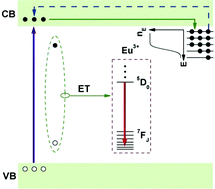Persistent luminescence from Eu3+ in SnO2 nanoparticles†
Abstract
Persistent luminescence phosphors, which are capable of emitting light for a long time after ceasing excitation, have shown great promise in diverse areas as bioprobes, lighting and displays. Exploring new materials to realize efficient persistent luminescence is a goal of general concern. Herein, we report a novel persistent luminescence phosphor based on Eu3+-doped SnO2 nanoparticles (NPs). The afterglow decay behaviour, the trap depth distribution as well as the underlying mechanism for persistent luminescence of the NPs were comprehensively surveyed by means of thermoluminescence and temperature-dependent afterglow decay measurements. It was found that the thermal activation mechanism is responsible for the afterglow decay of the NPs with an inverse power-law exponent of 1.0 (or 1.7) in the temperature region below (or above) 220 K. In particular, the co-existence of uniform and exponential distributions in trap depths may result in such a unique afterglow decay behaviour. These results reveal the great potential of SnO2 NPs as an excellent host material for Eu3+ doping for the generation of efficient persistent luminescence.


 Please wait while we load your content...
Please wait while we load your content...